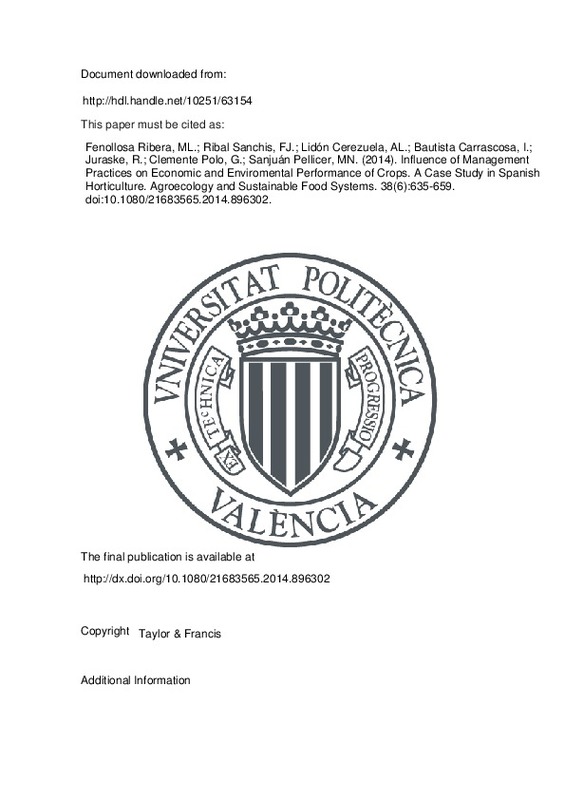De Backer, E., Aertsens, J., Vergucht, S., & Steurbaut, W. (2009). Assessing the ecological soundness of organic and conventional agriculture by means of life cycle assessment (LCA). British Food Journal, 111(10), 1028-1061. doi:10.1108/00070700910992916
Basset-Mens, C., Anibar, L., Durand, P., & van der Werf, H. M. G. (2006). Spatialised fate factors for nitrate in catchments: Modelling approach and implication for LCA results. Science of The Total Environment, 367(1), 367-382. doi:10.1016/j.scitotenv.2005.12.026
Basset-Mens, C., Kelliher, F. M., Ledgard, S., & Cox, N. (2009). Uncertainty of global warming potential for milk production on a New Zealand farm and implications for decision making. The International Journal of Life Cycle Assessment, 14(7), 630-638. doi:10.1007/s11367-009-0108-2
[+]
De Backer, E., Aertsens, J., Vergucht, S., & Steurbaut, W. (2009). Assessing the ecological soundness of organic and conventional agriculture by means of life cycle assessment (LCA). British Food Journal, 111(10), 1028-1061. doi:10.1108/00070700910992916
Basset-Mens, C., Anibar, L., Durand, P., & van der Werf, H. M. G. (2006). Spatialised fate factors for nitrate in catchments: Modelling approach and implication for LCA results. Science of The Total Environment, 367(1), 367-382. doi:10.1016/j.scitotenv.2005.12.026
Basset-Mens, C., Kelliher, F. M., Ledgard, S., & Cox, N. (2009). Uncertainty of global warming potential for milk production on a New Zealand farm and implications for decision making. The International Journal of Life Cycle Assessment, 14(7), 630-638. doi:10.1007/s11367-009-0108-2
Blengini, G. A., & Busto, M. (2009). The life cycle of rice: LCA of alternative agri-food chain management systems in Vercelli (Italy). Journal of Environmental Management, 90(3), 1512-1522. doi:10.1016/j.jenvman.2008.10.006
Carlsson Reich, M. (2005). Economic assessment of municipal waste management systems—case studies using a combination of life cycle assessment (LCA) and life cycle costing (LCC). Journal of Cleaner Production, 13(3), 253-263. doi:10.1016/j.jclepro.2004.02.015
Contreras, W. A., Lidón, A. L., Ginestar, D., & Bru, R. (2009). Compartmental model for nitrogen dynamics in citrus orchards. Mathematical and Computer Modelling, 50(5-6), 794-805. doi:10.1016/j.mcm.2009.05.008
Prudêncio da Silva, V., van der Werf, H. M. G., Spies, A., & Soares, S. R. (2010). Variability in environmental impacts of Brazilian soybean according to crop production and transport scenarios. Journal of Environmental Management, 91(9), 1831-1839. doi:10.1016/j.jenvman.2010.04.001
Jan, P., Dux, D., Lips, M., Alig, M., & Dumondel, M. (2012). On the link between economic and environmental performance of Swiss dairy farms of the alpine area. The International Journal of Life Cycle Assessment, 17(6), 706-719. doi:10.1007/s11367-012-0405-z
Juraske, R., & Sanjuán, N. (2011). Life cycle toxicity assessment of pesticides used in integrated and organic production of oranges in the Comunidad Valenciana, Spain. Chemosphere, 82(7), 956-962. doi:10.1016/j.chemosphere.2010.10.081
Lidón, A., Ramos, C., & Rodrigo, A. (1999). Comparison of drainage estimation methods in irrigated citrus orchards. Irrigation Science, 19(1), 25-36. doi:10.1007/s002710050068
McDevitt, J. E., & Milà i Canals, L. (2011). Can life cycle assessment be used to evaluate plant breeding objectives to improve supply chain sustainability? A worked example using porridge oats from the UK. International Journal of Agricultural Sustainability, 9(4), 484-494. doi:10.1080/14735903.2011.584473
Michelsen, J. (2001). Recent Development and Political Acceptance of Organic Farming in Europe. Sociologia Ruralis, 41(1), 3-20. doi:10.1111/1467-9523.00167
Meisterling, K., Samaras, C., & Schweizer, V. (2009). Decisions to reduce greenhouse gases from agriculture and product transport: LCA case study of organic and conventional wheat. Journal of Cleaner Production, 17(2), 222-230. doi:10.1016/j.jclepro.2008.04.009
Mouron, P., Nemecek, T., Scholz, R. W., & Weber, O. (2006). Management influence on environmental impacts in an apple production system on Swiss fruit farms: Combining life cycle assessment with statistical risk assessment. Agriculture, Ecosystems & Environment, 114(2-4), 311-322. doi:10.1016/j.agee.2005.11.020
Mouron, P., Scholz, R. W., Nemecek, T., & Weber, O. (2006). Life cycle management on Swiss fruit farms: Relating environmental and income indicators for apple-growing. Ecological Economics, 58(3), 561-578. doi:10.1016/j.ecolecon.2005.08.007
Pascual, B., Maroto, J. V., LóPez-Galarza, Sa., Sanbautista, A., & Alagarda, J. (2000). Chufa (Cyperus esculentus L. var. sativus boeck.): An unconventional crop. studies related to applications and cultivation. Economic Botany, 54(4), 439-448. doi:10.1007/bf02866543
Ribal, J., Sanjuán, N., Clemente, G., & Fenollosa, M. L. (2011). Medición de la ecoeficiencia en procesos productivos en el sector agrario. Caso de estudio sobre producción de cítricos. Economía Agraria y Recursos Naturales, 9(2), 125. doi:10.7201/earn.2009.02.06
Rosenbaum, R. K., Bachmann, T. M., Gold, L. S., Huijbregts, M. A. J., Jolliet, O., Juraske, R., … Hauschild, M. Z. (2008). USEtox—the UNEP-SETAC toxicity model: recommended characterisation factors for human toxicity and freshwater ecotoxicity in life cycle impact assessment. The International Journal of Life Cycle Assessment, 13(7), 532-546. doi:10.1007/s11367-008-0038-4
Sanjuan, N., Ribal, J., Clemente, G., & Fenollosa, M. L. (2011). Measuring and Improving Eco-efficiency Using Data Envelopment Analysis. Journal of Industrial Ecology, 15(4), 614-628. doi:10.1111/j.1530-9290.2011.00347.x
Sanjuan, N., Ubeda, L., Clemente, G., Mulet, A., & Girona, F. (2005). LCA of integrated orange production in the Comunidad Valenciana (Spain). International Journal of Agricultural Resources, Governance and Ecology, 4(2), 163. doi:10.1504/ijarge.2005.007198
Saxton, K. E., Rawls, W. J., Romberger, J. S., & Papendick, R. I. (1986). Estimating Generalized Soil-water Characteristics from Texture1. Soil Science Society of America Journal, 50(4), 1031. doi:10.2136/sssaj1986.03615995005000040039x
Thomassen, M. A., Dolman, M. A., van Calker, K. J., & de Boer, I. J. M. (2009). Relating life cycle assessment indicators to gross value added for Dutch dairy farms. Ecological Economics, 68(8-9), 2278-2284. doi:10.1016/j.ecolecon.2009.02.011
Tzilivakis, J., Jaggard, K., Lewis, K. A., May, M., & Warner, D. J. (2005). Environmental impact and economic assessment for UK sugar beet production systems. Agriculture, Ecosystems & Environment, 107(4), 341-358. doi:10.1016/j.agee.2004.12.016
Van der Werf, H. M. G., Kanyarushoki, C., & Corson, M. S. (2009). An operational method for the evaluation of resource use and environmental impacts of dairy farms by life cycle assessment. Journal of Environmental Management, 90(11), 3643-3652. doi:10.1016/j.jenvman.2009.07.003
Van Zeijts, H., Leneman, H., & Wegener Sleeswijk, A. (1999). Fitting fertilisation in LCA: allocation to crops in a cropping plan. Journal of Cleaner Production, 7(1), 69-74. doi:10.1016/s0959-6526(98)00040-7
Venkat, K. (2012). Comparison of Twelve Organic and Conventional Farming Systems: A Life Cycle Greenhouse Gas Emissions Perspective. Journal of Sustainable Agriculture, 36(6), 620-649. doi:10.1080/10440046.2012.672378
[-]







![[Cerrado]](/themes/UPV/images/candado.png)


